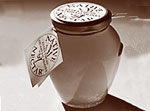 Guajillo honey looms large in the history, culture and economy of southwestern Texas, particularly in the development of Uvalde County, located about 165 miles southwest of the state capital, Austin. Guajillo honey is crystal white with a pearly reflection like new milk or a very light amber color. Guajillo has an extremely delicate and distinctive taste that is described as very light, mild, rich, smooth and sweet, with a hint of lavender. It has a perfume-like fragrance.
Guajillo honey looms large in the history, culture and economy of southwestern Texas, particularly in the development of Uvalde County, located about 165 miles southwest of the state capital, Austin. Guajillo honey is crystal white with a pearly reflection like new milk or a very light amber color. Guajillo has an extremely delicate and distinctive taste that is described as very light, mild, rich, smooth and sweet, with a hint of lavender. It has a perfume-like fragrance.
Guajillo (or Huajilla) is a wild desert bush that is native to Southwestern Texas and Northern Mexico and a member of the "acacia" plant family. Guajillo is a spreading shrub that sprouts prolifically from the base when disturbed. The plant is usually a medium-sized shrub but can grow into a small tree to 15 feet tall. The leaves are bipinnate with five to nine pairs of pinnae and 30 to 50 pairs of leaflets. They are also fernlike in appearance and can reach a length of 4 to 6 inches long. The white flowers are found blooming from November to March. Branches are often armed with short recurved prickles. Guajillo grows in sandy soils and shallow ridge sites in south Texas and the very southern portion of the Texas Hill Country.
The plant blooms in March and early April, and it is during this time that bees seek out the little blonde blossoms that give Guajillo honey both its unique flavor and color. Guajillo honey is crystal white with a pearly reflection like new milk or a very light amber color. Guajillo has an extremely delicate and distinctive taste that is described as very light, mild, rich, smooth and sweet, with a hint of lavender. It has a perfume-like fragrance. The honey is cold centrifuge extracted, retaining the beneficial antioxidants and amino acids that would otherwise be depleted during a high temperature filtration process.
Guajillo honey looms large in the history, culture and economy of southwestern Texas, particularly in the development of Uvalde County, located about 165 miles southwest of the state capital, Austin. During the 1870's when settlers were establishing farms and ranches in Uvalde County, they discovered caves and hollow trees full of bees and honey - a "bee paradise." The land was nicknamed "brush country" because of the cat claw, kinnikinnick, white brush and Guajillo bushes. Guajillo was the main honey plant and the bees that fed on the Guajillo blooms produced a mild, light colored delicious honey. The bees played an important role in pollination of many area crops most notably cucumbers and cantaloupe.
Uvalde became famous for producing and shipping delicious honey and was often called "the honey capital." The Southern Pacific Railroad initially played a major role in marketing Uvalde Honey - Texas beekeepers traveled to Uvalde to ship their honey all over the world.
The Uvalde bee industry developed a product that received first place in the 1900 Paris World's Fair. The first shipment was a case of bulk comb honey from D. M. Edwards in Uvalde in July of 1883. Entrepreneur James Whitecotton of Laguna gained attention as the largest honey dealer in the country with record sales estimated at a million pounds annually during the 1890s. In 1900, Uvalde County produced 161,800 pounds of Guajillo honey.
Honey, or the pursuit of it, also played a large role in the folklore of southwest Texas, according to a 1930 article by H. B. Parks, in the Southwest Review entitled, "The Lost Honey Mines in Texas. "The tales of bee-caves have much in common with stories about lost mines," says Parks. "The mouths of the caves were supposed to be guarded by huge rattlesnakes, vicious bats, scorpions; occasionally, by ghosts. Usually, as the story goes, some surveyor entered the cave about thirty years ago and reported vast rooms filled with honey in pure white combs. Often a well-driller in the vicinity has passed, they say, through just thirty feet of honey and wax. And someone can always (for a certain consideration and not otherwise) show you the location of the cave."

